
The aim of the Imperial Airways Eastern Route, along with the parallel development of the Imperial Airways African Route, was to link the countries of the British Empire.

Imperial Airways was formed on 31 March 1924 by amalgamating British Marine Air Navigation, Daimler Airways, Handley Page Transport and Instone Air Line.
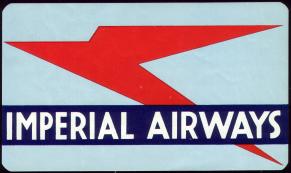
The Eastern Route was developed over a twenty year period from 1921 to 1940 with Imperial Airways first regular airmail service over part of the route starting in 1927.
Over the years, there were many changes due both to political
problems and technical advances.
The final extension to New Zealand was not achieved until
1940, shortly after Imperial Airways had become part of
BOAC.
The first steps, 1921
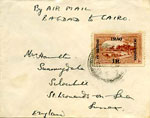
In 1921, the RAF began a weekly airmail service between Cairo and Baghdad. From October 1921, private as well as official mail was flown.
As the route between Cairo and Baghdad was largely over
featureless desert, a 400
mile long track was laid out as a navigation aid.
(In places, a plough was used to make a furrow!)
Cairo - Baghdad - Basra, 1927
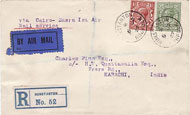
On January 12, the RAF Cairo - Baghdad service was taken over by Imperial Airways and extended to Basra in the Persian Gulf. They used DH 66 Hercules aircraft.
From London, mail went by sea to Port Said and from there to Cairo by rail.
From Basra, there was a regular mail boat service to Bombay.
London - Karachi, March 1929
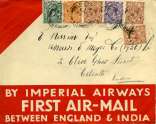
The long awaited Imperial Airways London to Karachi service started on 30 March 1929. The journey took 7 days.
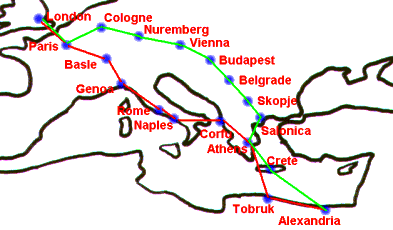
The route from London was by air to Basle and then by rail to Genoa. The flight from Genoa to Alexandria was by Short Calcutta flying boat. The route from London to Egypt changed several times in the first few years: the initial route with the intermediate stops is in red.
The route from Alexandria to Karachi followed the existing route to Basra and was then via Persia. It is shown below.
The plane was a DH 66 Hercules.
The delay in setting up the service was due to problems
in negotiating flying rights over Persia.
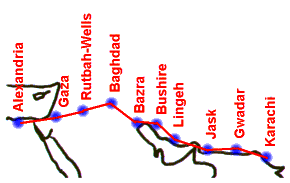 Mail for New Zealand was carried on the
first flight although it was
not until the flight of 31 August 1929 that the Post Office
officially announced that mail could be flown from the UK to Karachi
and then sent on
to Singapore, Australia, Hong Kong and New Zealand.
Unfortunately, the flight of 31 August crashed at Jask in Persia
and all mail was destroyed.
Mail for New Zealand was carried on the
first flight although it was
not until the flight of 31 August 1929 that the Post Office
officially announced that mail could be flown from the UK to Karachi
and then sent on
to Singapore, Australia, Hong Kong and New Zealand.
Unfortunately, the flight of 31 August crashed at Jask in Persia
and all mail was destroyed.
The first successful flight with mail for onward delivery left London on 7 September. There was an airmail rate of 6d in addition to the normal surface rate of 1½d.
As well as being flown to Karachi, mail for New Zealand could
be flown on the Perth - Adelaide
route for an additional 3d airmail fee.
Changes to route, November 1929
As early as 13 and 20 April, IA experimented with missing out Tobruk and in October some flights landed instead at Mersa Matruh (Egypt) [1].
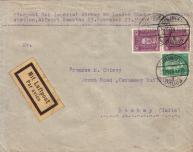
There were major problems with the Italian Government concerning flying rights over Italy. Hence, on 2 November 1929 the route from London to Athens was moved north (green line in the above map) via Cologne, Vienna, Budapest and Belgrade and was flown by an AW Argosy. From Athens the route was via Suda Bay and Mersa Mutrah to Alexandria.
Because of the mountains between Skopje and Salonica, the all-air route was closed after only two flights. Starting with the flight leaving London on November 16, part of the journey between London and Athens was by train. According to Wingent [1], bad weather in Europe and damage to three Calcutta flying boats meant that virtually no two journeys in November - December 1929 took the same route.
With this route change the airmail fee from UK to Karachi was reduced from 6d to 5d per ½oz.
Mail from Australia, December 1929
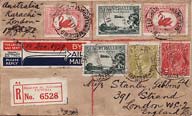
The first acceptance from Australia
left Fremantle, Western Australia on December 15, 1929.
It was flown from Karachi on 30 December and arrived in London
on 9 January [1].
Extension to Delhi, December 1929

On 29 December, the London - Karachi service was extended to Delhi. The first flight from London connecting with this extension left on December 21, but the official announcement was not until after the flight had left.
The first announced flight over the extended route left London on December 28. The route between Cologne and Athens was by train as described in the previous section.
Change to route, January 1930
From the middle of January 1930, the route between Paris and Athens
was entirely by train (the Simplon Orient Express).
London - Paris was flown, but, in the opposite direction,
Paris - London was by surface.
Athens - Alexandria was now via Mirabella in Crete [1].
Change to route, April 1930

In April 1930, the air route from Cologne to Athens was re-opened, but the Skopje (Uskub) - Salonica section remained by train. London to Skopje was by an AW Argosy while Salonica - Alexandria was by Short Calcutta flying boat.
Salonica was now the Imperial Airways flying boat terminal
and air mail was accepted from there for the first time.
New Zealand to UK via Karachi, July 1930

Although mail could be sent from London to New Zealand via Karachi from 1929, it was not until July 1930 that mail could be sent on this route from New Zealand. The first mail left New Zealand on 4 July 1930 and was additionally flown on the Adelaide - Perth route of Western Australian Airways. It arrived in London on 4 August.
The first mail flown only on the Karachi - London service left New Zealand on 11 July. The route was by sea to Colombo (in modern Sri Lanka) via Australia and then on to Karachi by surface mail. The Karachi - London air mail arrived in England on 11 August.
Change to route, September 1930
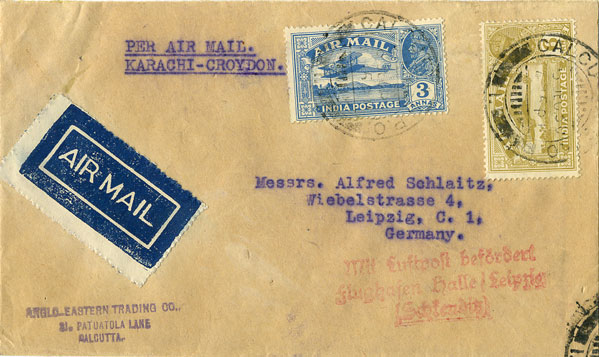
With the onset of winter, the route between London and Athens was
a combination of air and rail.
The route was London - Cologne - Nuremburg by air,
Nuremburg - Vienna by rail, Vienna - Nish (Serbia) by air
and Nish - Athens by rail.
Change to route, February 1931
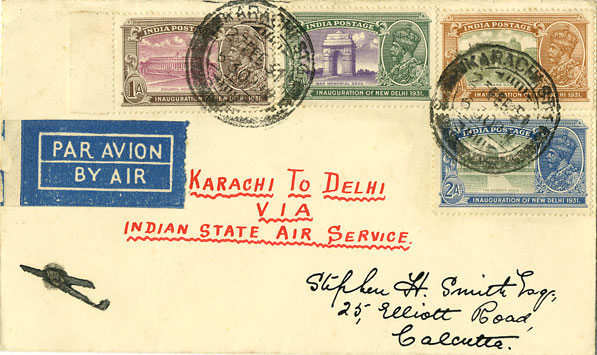
In February 1931, Paris - Athens was again changed to be by rail
(the Simplon Orient Express) [1] while London - Paris was flown
in both directions.
Inclusive rate, March 1931

Until March 1931, postal rates were calculated as a surcharge on
top of the surface rate.
From March 12, an inclusive rate was applied to
mail from the UK to New Zealand
although the previous system
continued to apply to mail from New Zealand.
Experimental extension to Australia, April 1931
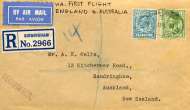
The first of two experimental flights to Australia left Croydon on April 4. There already was a regular Imperial Airways service from London to Delhi, a Qantas service from Darwin to Brisbane and an Australian National Airways service from Brisbane to Melbourne. The plan was to connect these services with Imperial Airways flying the missing leg from Delhi to Darwin.
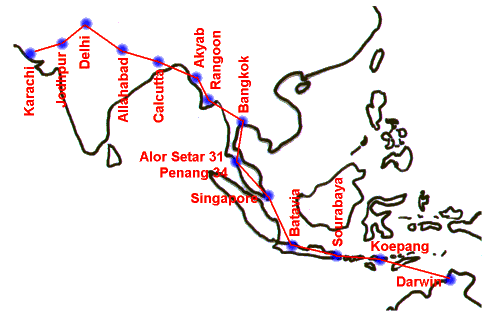
The Imperial Airways DH 66 Hercules left Karachi on 13 April and Singapore on the 16th, but crashed at Koepang in Timor in the Dutch East Indies on 19 April.
Kingsford Smith, with G.U. Allan as co-pilot, flew the Southern Cross from Sydney to Koepang on 21-24 April to pick up the mail and take it to Darwin where he arrived on 25 April.
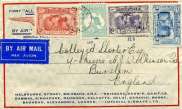 The return flight
left Melbourne on 23 April.
It was flown by ANA to Brisbane and by Qantas to Darwin
on 26 April.
Kingsford Smith, who had arrived in Darwin from Koepang
on the 25th,
flew the mail from Darwin to Akyab in Burma where it was
picked up by Imperial Airways on 3 May and carried to London
arriving on 14 May.
The return flight
left Melbourne on 23 April.
It was flown by ANA to Brisbane and by Qantas to Darwin
on 26 April.
Kingsford Smith, who had arrived in Darwin from Koepang
on the 25th,
flew the mail from Darwin to Akyab in Burma where it was
picked up by Imperial Airways on 3 May and carried to London
arriving on 14 May.
The second experimental flight
left England on 25 April 1931
and arrived in Melbourne on 14 May.
The return flight
left on May 15 and arrived in the UK on June 2.
Resumption of route via Genoa, 16 May 1931

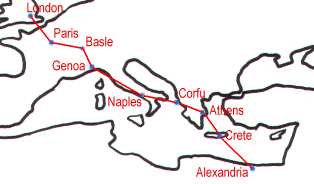
The revised route to Athens was similar to the original route of 1929 with Naples replacing Rome. The planes used between Genoa and Alexandria were Short Kent flying boats.
The first flight on the new route left London for Basle on 16 May on an AW Argosy. The mail was sent by rail to Genoa and flown to Corfu on 17 May and on to Alexandria via Athens and Mirabella (Crete) on 18 May.
Instead of the onward flight being from Alexandria, passengers and mail were now transferred to Cairo by rail. The first onward flight from Cairo was by DH 66 on 19 May to Baghdad. Baghdad to Jask was on 20 May, Jask to Karachi on 21 May and Karachi to Delhi was on 22 May. To speed up the service, the Baghdad to Basra section on 20 May was by night with the DH 66 leaving at 3am.
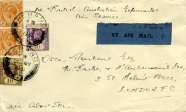
The first airmail from Delhi on the revised route left on May 20. The return of the second experimental airmail from Australia connected with the second dispatch by this new route, leaving Delhi on May 27 and arriving in London on June 2.
Normal airmail for/from Australia and New Zealand continued to be
sent from/to Karachi by mailboat.
Changed route, 17 October 1931

Due to further problems with flying over Italy, on 17 October 1931 the route was again changed. The journey from Paris to Brindisi in the south of Italy was now by train.
Kent flying boats now flew from Brindisi to Athens via Corfu and then, instead of flying from Athens to Alexandria, Egypt was omitted from the route which was now to Haifa followed by a car journey (by Nairn Transport) to Tiberias and from there by air to Baghdad.
Previously, the London - India and London - Africa services
only separated in Egypt.
There were now two completely different services from
London with the Indian service leaving on a Saturday
and the African service on a Wednesday.
Regular London - Capetown airmail, January 1932
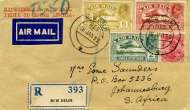
The Imperial Airways Africa route was extended to South Africa with the first regular airmail leaving England on 20 January 1932.
Mail was accepted for this flight
from India.
It was flown to Tiberias on the Eastern Route and from there
to Cairo where it joined the London - Africa flight.
The mail arrived in Cape Town on 2 February.
Call at Cyprus, 19 April 1932
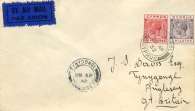
The change of October 17, 1931 meant that the route was now over Cyprus. For the flight leaving London on 16 April, 1932 stops were made at Limassol and Rhodes. The first flight arrived in Cyprus on 19 April.
The first flight in the opposite direction left Cyprus
on 24 April and arrived in London on 28 April.
New Zealand - Capetown, July 1932
 The first acceptance of mail from
New Zealand to Africa was on 30 June 1932.
It was carried by surface to Karachi and then was flown
via Tiberias to Cairo where it joined
the regular London - South Africa airmail.
The first acceptance of mail from
New Zealand to Africa was on 30 June 1932.
It was carried by surface to Karachi and then was flown
via Tiberias to Cairo where it joined
the regular London - South Africa airmail.
It arrived in Cairo on 30 July and in Cape Town
on 7 August.
Via Bahrain and Sharja, 1 October 1932
 For the flight leaving London on
1 October 1932, the route was changed from the
Persian to the Arabian side of the Persian Gulf
and Handley Page HP 42
airliners were introduced on the route to Karachi.
For the flight leaving London on
1 October 1932, the route was changed from the
Persian to the Arabian side of the Persian Gulf
and Handley Page HP 42
airliners were introduced on the route to Karachi.
Another change was that Rhodes and Limassol were dropped from the route from Athens and replaced by Castelrosso. Also, the car journey from Haifa to Tiberias was no longer necessary as the Kent flying boats now flew to Lake Tiberias (Sea of Galilee) where passengers were transferred to the HP 42 airliners.
A stop in Kuwait was added in January 1933.
Route changed back to Egypt, January 1933
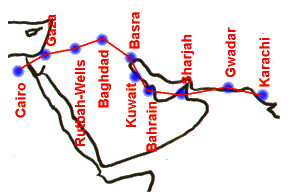 In January 1933, the route from Athens reverted to Crete - Alexandria -
Cairo - Gaza - Baghdad.
In January 1933, the route from Athens reverted to Crete - Alexandria -
Cairo - Gaza - Baghdad.
Brindisi to Alexandria was by Kent flying boat,
Alexandria to Cairo was by rail and Cairo to Karachi
was by Handley Page HP 42.
Extension to Calcutta, July 1933

From July 1933, the London - Delhi service was extended to Calcutta. The first flight left London on 1 July and arrived in Calcutta on 8 July.
The return flight left Calcutta on 11 July and arrived in
London on 17 July.
Extension to Rangoon, September 1933
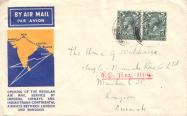 From September 1933 the service was
extended to Rangoon.
The flight left London on 23 September and
arrived in Rangoon on 1 October.
From September 1933 the service was
extended to Rangoon.
The flight left London on 23 September and
arrived in Rangoon on 1 October.
The return flight left Rangoon on 2 October and arrived in London
on 10 October.
Extension to Singapore, December 1933
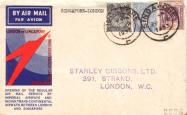 In December 1933 the service was extended from Rangoon
to Singapore
via Bangkok and Alor Star.
The flight left London on 9 December and arrived in Singapore
on December 19.
In December 1933 the service was extended from Rangoon
to Singapore
via Bangkok and Alor Star.
The flight left London on 9 December and arrived in Singapore
on December 19.
The return left Singapore on 1 January and arrived in
London on 10 January 1934.
Extension to Australia, December 1934
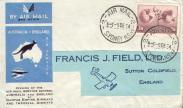
In December 1934, the Empire Air Service was extended to Brisbane in Australia and that then became the standard airmail route between the UK and New Zealand although, of course, the New Zealand - Australia leg was still by sea.
Qantas had the contract for the Brisbane - Singapore section,
but as their DH 86 fleet had been grounded, Imperial
Airways flew the entire Karachi - Darwin section in an
AW Atalanta.
Qantas took over the Darwin - Singapore leg in
February 1935.
Extension to Hong Kong, March 1936
 In March 1936, an Imperial Airways service was started
to Hong Kong
from Penang where it connected with the
London - Singapore service.
In March 1936, an Imperial Airways service was started
to Hong Kong
from Penang where it connected with the
London - Singapore service.
The first connecting mail from London left on 14 March. The service left Penang on 23 March for Saigon and arrived in Hong Kong on 24 March.
The first return airmail from Hong Kong left on
27 March.
Southampton - Alexandria by flying boat, 13 December 1936
This was an experimental flight by Short Empire flying boat.
Marseilles - Alexandria by flying boat, 2 January 1937
Mail was sent by rail from Paris to Marseilles instead of from Paris to Brindisi. The route for the Empire flying boat was Marseilles - Rome - Brindisi - Athens - Mirabella Bay (Crete) - Alexandria.
Mail in the opposite direction was carried by the old route and was still sent by rail from Brindisi. This strange combination was carried out in reverse for the England - Alexandria mail destined for Africa and enabled the new flying boat to be fully used.
Southampton - Alexandria by flying boat, 6 February 1937
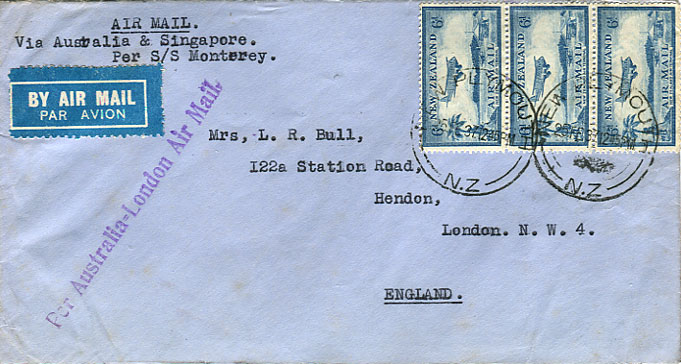
This was the beginning of the regular service. However, due to mechanical failure, the flight had to return to Southampton. It was then delayed by bad weather and eventually left on 8 February. It arrived in Brisbane on 20 February.
On June 29, the first stage of the Empire Air Mail Scheme was started. The air mail rate to Africa was now 1½d per ½ oz. The EAMS was an All-up scheme, i.e. all mail was flown.
Southampton - Karachi by flying boat, 3 October 1937
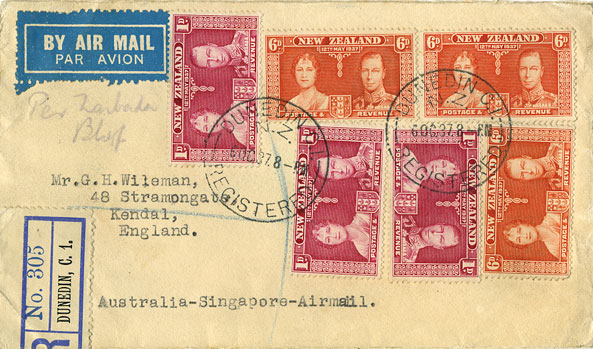
The route from Alexandria was Tiberias (Lake of Galilee), Baghdad, Basra, Bahrein, Dubai, Gwador, Karachi. The Empire flying boat left Southampton on 3 October and arrived in Karachi on 8 October. The first flight in the opposite direction left Karachi on 7 October and arrived in Southampton on 10 October.
Revised route to Hong Kong, December 1937
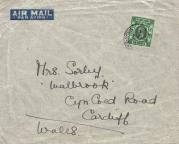
From December 1937, the connection between the Eastern Route and Hong Kong was changed from Penang to Bangkok. The route was now via Udang and Hanoi.
The Imperial Airways (later BOAC) Bangkok - Hong Kong
service ceased in
October 1940 and was replaced by the CNAC service from
Rangoon via Chungking.
Southampton - Singapore by flying boat, 17 February 1938
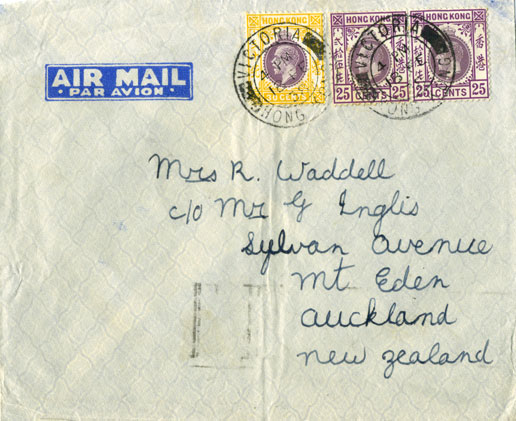
The first service by flying boat from Karachi to Singapore was on 22 - 24 February. That meant that the flight leaving Southampton on 17 February 1938 and arriving in Singapore on 24 February was entirely by flying boat. Southampton - Karachi was by Circe and Karachi - Singapore by Coogee [2].
The first flight in the opposite direction left Singapore on 28 February
and arrived in Southampton on 7 March.
Second Stage of EAMS, 23 February 1938
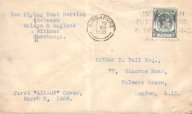
The second stage of the Empire Air Mail Scheme was started with the flight leaving Southampton on 23 February 1938 and arriving in Singapore on 2 March. The air mail rate to India and Malaya was now 1½d per ½ oz. The reduction had been made possible by the introduction of flying boats on the Karachi - Singapore leg the week before.
The first flight in the opposite direction left Singapore on 2 March
and arrived in Southampton on 9 March.
The postage rate from Malaya was 8c.
Southampton - Australia by flying boat, 26 June 1938
The start of the regular flying boat service all the way to Australia was on 26 June. Two Empire flying boats left Southampton and arrived in Singapore on 1 July. The mail was transferred to an Empire flying boat belonging to Qantas under the command of G.U. Allan. It arrived in Sydney, the new Qantas base for UK - Australia flights, on July 6.
The first flight in the opposite direction left Sydney on 7 July and arrived in Southampton on 18 July.
EAMS to Australia and New Zealand, 28 July 1938
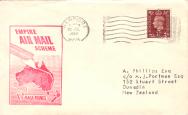 On 28 July 1938, the first dispatch of mail left the UK
on the third stage of the
Empire Air Mail Scheme.
The air mail rate from the UK to Australia and New Zealand
was now 1½d per ½ oz.
On 28 July 1938, the first dispatch of mail left the UK
on the third stage of the
Empire Air Mail Scheme.
The air mail rate from the UK to Australia and New Zealand
was now 1½d per ½ oz.
New Zealand joined the scheme on July 26, but the first
dispatch was not until August 4.
Australia only reduced its airmail rates to 5d per ½ oz.
End of EAMS, 5 September 1939
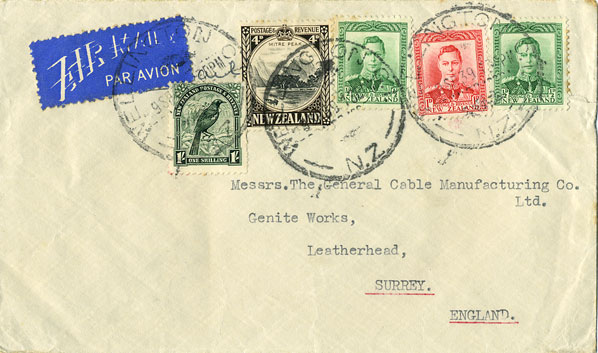
With the beginning of World War II on 3 September, the cost
of airmail was
returned to its previous rate
which, in the case of
New Zealand was 1s 3d from the UK and 1s 6d to the UK.
Regular trans-Tasman airmail, 30 April 1940

Tasman Empire Airways (TEAL) inaugurated the regular trans-Tasman airmail service from Auckland to Sydney on 30 April 1940 with the first return flight from Australia being on May 2. The Short S30 Empire flying boat Aotearoa flew both these flights.
At Sydney, there was a connection with the regular Australia - UK service. Qantas flew from Sydney to Singapore while BOAC, which had replaced Imperial Airways on 1 April, flew from Singapore to the UK.
All scans were made by the author.
Information on this page is taken from:
Airmails of New Zealand, volume 2 (1986) compiled by
Douglas A Walker, and
The New Zealand Airmail Catalogue, (2nd Edition, 1994)
by James Stapleton.
Both are published by the
Air Mail Society of New Zealand
Further information on postage rates is in:
The Development of Airmail Routes from the United Kingdom Part 1:
India and the Far East, J Rawlins, Air Mail News, vol 35,
pp 68-73, June 1992.
[1] Aircraft Movements on Imperial Airways' Eastern Route,
Vol 1, 1927 - 1937, Peter Wingent, Winchester 1999.
[2] Aircraft Movements on Imperial Airways' Eastern Route,
Vol 2, 1937 - 1939, Peter Wingent, Winchester 2005.